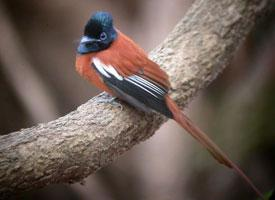
Súlyok és méretek
| Hossz | 17-tól 18-ig cm |
|---|
Állatleírás
The African paradise flycatcher (Terpsiphone viridis) is a strikingly beautiful and captivating bird species belonging to the Monarchidae family, renowned for their vibrant plumage and graceful flight. This species is widely distributed across sub-Saharan Africa, thriving in a variety of habitats ranging from dense forests to savannahs and even lush gardens. Its adaptability to different environments underscores its resilience and the broad ecological niche it occupies.Adult African paradise flycatchers exhibit a remarkable sexual dimorphism, particularly in terms of their plumage. Males are especially resplendent with their glossy black heads, deep blue to green iridescent throat and upper breast, and a back that displays a rich chestnut color. Their most distinctive feature, however, is the exceptionally long tail feathers that can be twice the length of their body, lending an air of elegance and grace as they flit through the air. These tail feathers are predominantly white, with a central pair that is often longer and more pronounced. Females and juveniles, while not as flamboyant as the males, possess their own charm with a more subdued palette that includes a greyish head and back, and a lighter underbelly. Both sexes have a narrow ring of bare skin around the eye, which is typically blue or aqua in color, adding to their exotic appearance.
Measuring approximately 17 to 19 cm in length, not including the male's long tail feathers, the African paradise flycatcher is a small to medium-sized bird. It has a slender body, a small head, and a sharp, pointed beak perfectly adapted for its insectivorous diet. These birds are agile fliers, adept at catching insects in mid-air or plucking them off leaves and branches. Their diet mainly consists of flies, beetles, moths, and occasionally spiders, which they hunt with remarkable dexterity.
The African paradise flycatcher is also known for its melodious calls and songs. Males often sing a variety of sweet, whistling tunes during the breeding season to attract females and to defend their territory against rivals. Their vocalizations add a layer of auditory beauty to their physical allure, making them a delight not only to observe but also to listen to.
Breeding behavior in this species is quite fascinating. They are monogamous, with pairs forming strong bonds. The construction of the nest is a cooperative effort, with both male and female participating in the building process. The nest, a neat cup-shaped structure made of twigs, grass, and spider webs, is often situated in the fork of a tree or shrub. The female lays two to three pale blue eggs, which she incubates for about 14 to 15 days. The chicks are altricial, born blind and featherless, and require intensive care and feeding by both parents until they fledge approximately two weeks later.
In addition to their aesthetic and ecological value, African paradise flycatchers play a significant role in controlling insect populations, thus contributing to the balance of their ecosystems. Their widespread presence across Africa, adaptability to different environments, and general resilience make them a common yet enchanting sight, embodying the rich biodiversity and natural beauty of the continent.
Új állatfotók
Top 10 állat
- Dolphin gull (Leucophaeus scoresbii)
- Diana monkey (Cercopithecus diana)
- Moustached guenon (Cercopithecus cephus)
- Greek tortoise (Testudo graeca)
- Stone loach (Barbatula barbatula)
- Galápagos tortoise (Geochelone nigra complex)
- Japanese macaque (Macaca fuscata)
- Russian tortoise (Testudo horsfieldii)
- Common flying dragon (Draco volans)
- Galápagos penguin (Spheniscus mendiculus)